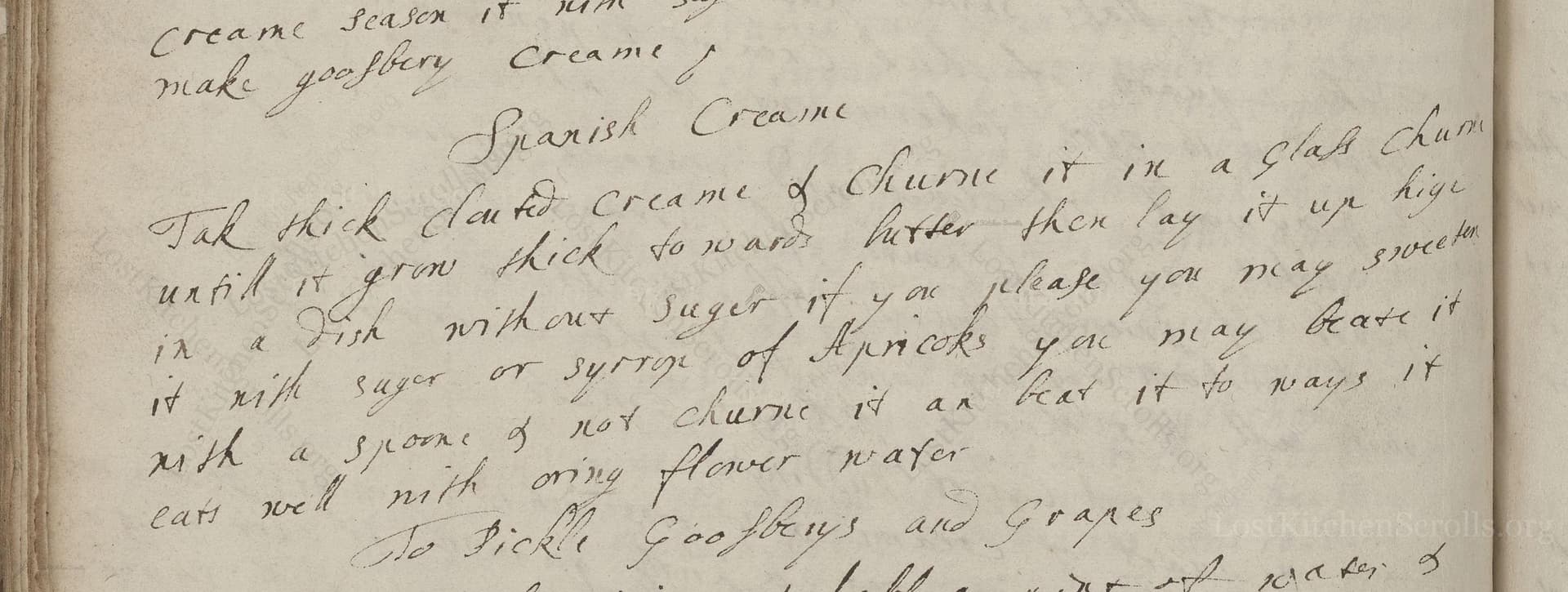Spanish Creame
From the treasured pages of Receipts in cookery and medicine 1700
Unknown Author

Spanish Creame
"Tak thick clouted Creame of Churnie it in a Glass Churn untill it grow thick towards butterr then lay it up high in a dish without suger if you please you may sweeten it with suger or syrope of Apricoks you may beate it with a spoone & not churne it an beat it to ways it eats well with oring flower water."
Note on the Original Text
The recipe is written in the conversational, somewhat improvisational English of the early 18th century. Spelling was fluid—‘orings’ for ‘orange’, ‘suger’ for ‘sugar’, and so on. Quantities are imprecise; cooks were expected to know by feel and at sight. Punctuation is minimal, and directions flow together, reflecting a time when written recipes were more reminder than instruction, aimed at the experienced household cook.

Title
Receipts in cookery and medicine 1700 (1700)
You can also click the book image above to peruse the original tome
Writer
Unknown
Era
1700
Publisher
Unknown
Background
Step into the kitchen of the early 18th century, where this charming culinary manuscript tempts tastebuds with recipes and secrets from a bygone era. A delicious journey for both the curious cook and the history lover.
Kindly made available by
Folger Shakespeare Library
This delightfully rich dessert comes from an English manuscript dating to around 1700, a period when creams and syllabubs reigned supreme at fashionable tables. Spanish Creame is one of countless elaborately prepared 'creams' popular amongst the European elite, reflecting the luxury of dairy, exotic sugars, and imported flower waters. The recipe's mention of 'churning' in a glass churn suggests a genteel, almost performative way of thickening cream, just until it threatened to break into butter, which was regarded as a mark of culinary finesse.

Historically, the cream would have been 'churned' in a small glass churn, or possibly beaten briskly with a wooden spoon or whisk in a bowl. Glass churns were dainty, decorative versions of the larger butter churns and allowed cooks—and sometimes guests—to observe the transformation of the cream. Dishes for serving would be wide and shallow, often elegant enough for the table, with pewter or ceramic spoons for serving.
Prep Time
10 mins
Cook Time
0 mins
Servings
4
We've done our best to adapt this historical recipe for modern kitchens, but some details may still need refinement. We warmly welcome feedback from fellow cooks and culinary historians — your insights support the entire community!
Ingredients
- 1 pint (2 cups) clotted cream (or substitute: 1 pint (2 cups) double cream, minimum 48% fat)
- 1–2 tablespoons caster sugar (optional)
- 2–3 teaspoons apricot syrup (optional, or substitute with other fruit syrup)
- Few drops orange flower water (optional)
Instructions
- Begin with about 1 pint (2 cups) of thick clotted cream (or substitute with high-fat double cream if clotted is unavailable).
- Place the cream in a large mixing bowl.
- Using a hand-held mixer or whisk, beat the cream until it thickens further, just before it separates into butter grains—about 3–7 minutes depending on your method and cream temperature.
- Traditionally, this was done in a glass churn, but a bowl and whisk replicate the process.
- Once the cream is luxuriously thick, carefully mound it high on a shallow serving dish.
- You may leave it unsweetened, or fold in sugar (about 1–2 tablespoons, to taste), or add a few teaspoons of apricot syrup for sweetness and perfume.
- For a floral touch, sprinkle with a few drops of orange flower water before serving.
- Serve chilled, with fresh fruits or small cakes for dipping, if desired.
Estimated Calories
400 per serving
Cooking Estimates
It takes about 5 minutes to beat the cream, with minimal prep needed. Each serving has about 400 calories if divided into 4 portions.
As noted above, we have made our best effort to translate and adapt this historical recipe for modern kitchens, taking into account ingredients nowadays, cooking techniques, measurements, and so on. However, historical recipes often contain assumptions that require interpretation.
We'd love for anyone to help improve these adaptations. Community contributions are highly welcome. If you have suggestions, corrections, or cooking tips based on your experience with this recipe, please share them below.
Join the Discussion
Rate This Recipe
Dietary Preference
Main Ingredients
Culinary Technique
Occasions

Den Bockfisch In Einer Fleisch Suppen Zu Kochen
This recipe hails from a German manuscript cookbook compiled in 1696, a time whe...

Die Grieß Nudlen Zumachen
This recipe comes from a rather mysterious manuscript cookbook, penned anonymous...

Ein Boudain
This recipe comes from an anonymous German-language manuscript cookbook from 169...

Ein Gesaltzen Citroni
This recipe, dating from 1696, comes from an extensive anonymous German cookbook...
Browse our complete collection of time-honored recipes



